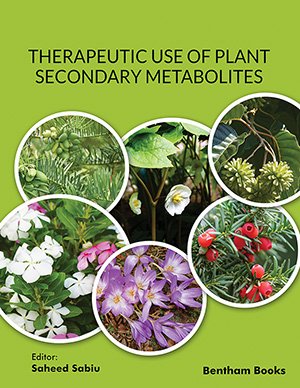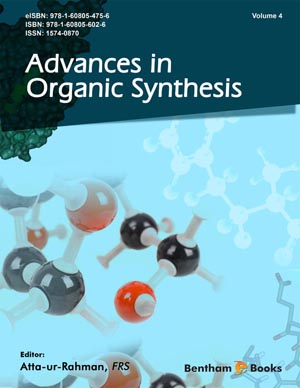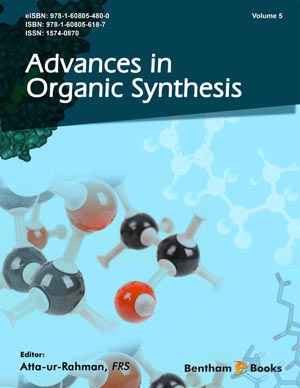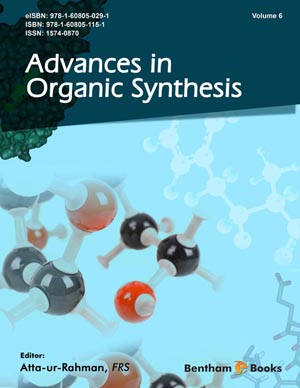The Role of Plant Secondary Metabolites in Health Management
Page: 1-20 (20)
Author: Taofik Olatunde Uthman*
DOI: 10.2174/9789815050622122010004
PDF Price: $30
Abstract
Plant secondary metabolites (PSM) are bioactive compounds produced by plants for protection against predatory organisms and to attract insects for pollination. Recently, greater attention is being focused on PSM due to their perceived ability to elicit pharmacological activities, including antihypertensive, antiarrhythmic, antimalarial, anticancer, analgesic, antispasmodic, antidiabetic, and antimicrobial effects. Therefore, many plant species are continually screened for PSM, such as alkaloids, flavonoids, terpenes, saponins, cardiac glycosides, fatty acids, steroids, and tannins with a view to exploiting them in the manufacture of drugs and pharmaceuticals. In this review, the pharmacological activities and possible mechanisms of action of selected PSM are discussed.
Medicinal Plants and Drug Discovery
Page: 21-49 (29)
Author: Emmanuel O. Ajani*
DOI: 10.2174/9789815050622122010005
PDF Price: $30
Abstract
Emerging communicable diseases, such as Ebola and Coronavirus Infection Disease (COVID-19), and non-communicable diseases related to diet and lifestyle, e.g., diabetes, have been increasing over the last two decades, having a great negative impact on the health services, which are already over-stretched. This again has been compounded by some largely unresolved diseases, such as malaria and HIV/AIDS, which are common parasitic and infectious diseases in many developing countries. Over several years, natural medicine has been a dependable alternative in the prevention and treatment of diseases and has been widely recognized as important for drug discovery and development. Over the world, traditional medicine has largely depended on natural products. The structural diversity and biological activity of natural products have made them a valuable source of drugs and drug leads. Several active compounds have been isolated from natural products. Among them, some follow their traditional uses while some others do not. For many years, plant’s bioactive compounds, otherwise referred to as secondary metabolites, have been the source of countless compounds and leads for drug discovery. The process of drug discovery includes the identification of a lead compound, which is then proposed for drug development. Drug discovery, therefore, encompasses moving from a screening hit to a compound becoming a therapeutic agent. It is a process that requires expertise and experience. In modern drug discovery research, techniques commonly employed include combinatorial chemistry, high-throughput screening, bioinformatics, proteomics and genomics.
Therapeutic Properties of Bioactive Secondary Metabolites in Essential Oil Crops
Page: 50-83 (34)
Author: Fikisiwe C. Gebashe, Adeyemi O. Aremu and Stephen O. Amoo*
DOI: 10.2174/9789815050622122010006
PDF Price: $30
Abstract
Medicinal herbs and their essential oils (EOs) are of commercial and industrial importance with diverse uses as forage and fiber crops, in food, cosmetics, perfumery and chemical industries, and in traditional medicine due to their phytochemical constituents and bioactivities. This chapter was aimed at documenting the therapeutic properties of major secondary metabolites in EOs extracted from six selected economically important medicinal herbs (Achillea millefolium L., Melissa officinalis L., Origanum majorana L., Pelargonium graveolens L'Hér. Rosmarinus officinalis L. and Thymus vulgaris L.). Forty-five compounds (mainly monoterpenes) were recorded as major compounds of the six medicinal herbs. The compounds possess varying biological activities, which include antimicrobial, anti-inflammatory, antioxidant and cytotoxicity properties. Other activities reported were antinociceptive, neuroprotective effects, acetylcholinesterase inhibition, anti-ulcerogenic, DNA protection, glutathione S-transferase activity, chemoprotective, anti-depressant and sedative effects. The compounds showed potential to be used as alternative agents as drugs, cosmetic ingredients and food additives. Though some scientific evidence has confirmed the use of these herbs in various industries, much work still needs to be done to comprehend the therapeutic application of their EOs and phytoconstituents to benefit from their full potential.
Bioactive Compounds as Therapeutic Intervention in Cancer Therapy
Page: 84-110 (27)
Author: Depika Dwarka, Himansu Baijnath and John Jason Mellem*
DOI: 10.2174/9789815050622122010007
PDF Price: $30
Abstract
Neither transmittable nor communicable, painstakingly the second most fatal disease worldwide, cancer has gained the interest of scientists who are attempting with tenacity to decrypt its unknown facets, discover new diagnosis techniques, as well as to create improved and more efficient treatment methods. A major impediment to effective cancer therapy is the inability to destroy the complete malignant tumour growth and evolution of tumour resistance. Chemotherapeutic drugs are known for their cell death mode of action, thereby incapacitating non-cancerous cells in the process. A successful anti-cancer drug should kill or debilitate cancer cells without causing unnecessary damage to normal cells. Administration of natural bioactive compounds exemplifies an alternative technique as they are associated with lower toxicities. These bioactive molecules are effective and demonstrate great specificity as they possibly operate as potent anti-oxidants and apoptosis inducers. Moderating apoptosis might be helpful in managing, treating, or deterring cancer. Significantly, bioactive compounds are providing such templates. Plants have a long history in cancer treatment. More than 3000 species have been known for their anti-cancer potential. Over 60% of currently used anti-cancer agents are derived in one way or another from higher plants. This chapter describes the roles and advancements of the use of bioactive compounds in the treatment of cancer.
Bioactive Compounds as Therapeutic Intervention in Mucocutaneous Cancers
Page: 111-138 (28)
Author: Henry A. Adeola*, Rashmi Bhardwaj, Aderonke F. Ajayi-Smith, Afsareen Bano, Tayo A. Adekiya, Michael C. Ojo, Raphael T. Aruleba, Adeniyi C. Adeola, Babatunji E. Oyinloye and Chinedu E. Udekwu
DOI: 10.2174/9789815050622122010008
PDF Price: $30
Abstract
There are several beneficial effects of plant bioactive compounds in the evidence-based prevention and treatment of mucocutaneous cancers. For instance, several bioactive compounds via various antioxidant and immunomodulatory mechanisms have been shown to positively improve different diseases, including cancer. Considering the complex, multifactorial processes that regulate genetic and cellular function in cancer development, the use of small phytochemical molecules capable of targeting multiple carcinogenetic genes and pathways is plausible. Furthermore, the identification of molecular targets and cognate dietary bioactive molecules in mucocutaneous cancer, using applied combinatorial chemistry approaches, potentially presents a key complementary ancillary tool for developing robust, physiologically bioavailable, diversity-oriented, and cost-effective therapies. These systems biology and omics-based theragnostic tools are crucial for the management of cancers that affect the oral mucous membranes and skin in a resourcelimited setting. Natural products and nutraceuticals are poised to ameliorate the burden of mucocutaneous cancers and improve the drug discovery pipelines if state-of-the-art research techniques are used to elucidate their therapeutic values in the era of precision medicine. Hence, this review focuses on the currently available and potential therapeutic benefits of plant bioactive compounds in the prevention and management of mucocutaneous cancers.
Bioactive Compounds as Therapeutic Intervention in Bacterial Infections
Page: 139-160 (22)
Author: Kazeem A. Alayande*, Abdulwakeel A. Ajao and Mariam O. Oyedeji- Amusa
DOI: 10.2174/9789815050622122010009
PDF Price: $30
Abstract
This study highlights the significance of drug resistance towards difficulties in the treatment of infectious diseases, the essence of bioactive compounds in therapeutic intervention, and the unique approach employed by bioactive compounds away from conventional synthetic drugs. Literature was gathered from different online databases to retrieve the required information. Bacterial resistance to antibiotics is a major concern that threatens clinical efforts in treating bacterial infections. This has grossly reduced clinical success on previously curable infections and/or sometimes results in a prolonged hospital stay. Antibiotics provide protection and remedy against infectious diseases. But the emergence of multi-drug resistance strains has inflicted untold loss of effectiveness on virtually every conventional antibiotic. Hence, scientific communities are propelled into seeking alternative therapies in a bid to mitigate the overwhelming consequence on public health. Bioactive molecules are important sources of newly derived therapeutic agents. They have minimal likelihood of inducing unintended immune reactions, reduced level of toxicity; are structurally diverse in nature, exhibit broad-spectrum therapeutic effects. Bioactive molecules are commonly present in small amounts in plant-based foods; and provide health benefits in addition to the basic nutritional values expected in foods. Several plant-based bioactive principles serve as inhibitors for drug resistance in order to enhance the effective delivery of the antibacterial compounds. Meat products are a good source of non-plant bioactive molecules, which are expressed in the form of peptides, vitamins, minerals and fatty acids. Other important sources include endophytic bacteria, endophytic fungi, probiotic bacteria, actinomycetes and marine organisms. Natural products are relatively safe when compared to their synthetic counterparts. As newly manufactured potent antibiotics become increasingly unavailable and/or unaffordable, bioactive compounds present viable alternatives. They are readily available and are derived from inexpensive raw materials via cheap technology.
The Use of Plant Secondary Metabolites in the Treatment of Bacterial Diseases
Page: 161-184 (24)
Author: Pillay Charlene*, Ramdhani Nishani and Singh Seema
DOI: 10.2174/9789815050622122010010
PDF Price: $30
Abstract
Plants produce an array of secondary metabolites identified as possible antimicrobial agents that are used across the globe to treat numerous diseases and ailments. These secondary metabolites serve as unique commercial sources of various pharmaceuticals, food additives and flavouring agents, and possess diverse industrial applications. Alkaloids, flavonoids, and polyphenols are secondary metabolites shown to attack numerous gram-positive and gram negative bacteria in response to microbial infections. Secondary plant metabolites have a detrimental effect on microbial cells in several ways, such as alteration of the structure and function of the cytoplasmic membrane as well as DNA/RNA synthesis, interference with intermediary metabolism, interaction with membrane proteins, a disruption in the movement of protons leading to ion leakage, enzyme synthesis inhibition, the clotting of cytoplasmic components and interference in typical cell communication. This ultimately results in cell death. The focus of this chapter is to provide an overview of the function and benefits of plant secondary metabolites as therapeutic agents to combat pathogenic bacterial infections.
Plant Secondary Metabolites in the Management of Degenerative Diseases
Page: 185-213 (29)
Author: Judith N. Ohanaka*, Uwazie C. Kenneth, Fatai O. Balogun and Saheed Sabiu
DOI: 10.2174/9789815050622122010011
PDF Price: $30
Abstract
Medicinal plants have been indispensable in the development of lead compounds for the management of human health. However, herbal remedies have not been explored maximally in modern therapeutics for the management of drug-resistant diseases, re-emerging diseases, metabolic syndrome, etc.
Several secondary metabolites with proven efficacious pharmacological effects have been identified from plants, some isolated but unfortunately never developed into a marketable pharmaceutical product.
Thus, this chapter provides resourceful information on the secondary metabolites of herbal plants with great pharmacological potential. Databases such as JSTOR, Science Direct, Google, PubMed, and Medline were explored for relevant information on this concept.
A spectrum of plant secondary metabolites with potent antibactarial, antiviral, antimalarial, anticancer, antidiabetic activities in different plant species were collated, the class of these metabolites and mechanism of action was compiled.
An acquaintance with efficacious secondary metabolites used in the management of various diseases will serve as a basic tool for Ethnomedical Scientists in the integration of folkloric knowledge in contemporary medicine for the formulation of herbal remedies with superior pharmacological relevance than conventional medicine.
Bioactive Compounds as Therapeutic Intervention in Neurodegenerative Diseases
Page: 214-237 (24)
Author: N. Suleiman*, I. Bulama and L.S. Bilbis
DOI: 10.2174/9789815050622122010012
PDF Price: $30
Abstract
Neurodegenerative disorders
have been implicated as the cause of many devastating diseases that are
characterized by gradual loss of susceptible neurons, that are increasingly
rising the prevalence of neurodegenerative diseases globally; however, therapeutics
for them are lacking. There is an urgent need to develop an effective therapy
that can combat the menace caused by disorders of neurodegenerative origin such
as Alzheimer's and Parkinson’s diseases, stroke, and traumatic brain injury.
Peerreviewed articles were explored for the purpose of this review. Several
natural products from medicinal plants have been reported to have phytochemical
components with bioactive effects in addition to nutritional value. An appropriate
bioactive component is essential for a healthy lifestyle as it plays a
significant role in the modulation of neurodegenerative diseases. This review
covers the mechanism of action of neurodegenerative disorders and highlights
selected classes of bioactive compounds and their effects on neurodegenerative
disorders. The use of bioactive compounds in the management of
neurodegenerative diseases could solve the problem of the nonavailability of
therapy.
Green Synthesis Application in Diabetes Therapy
Page: 238-268 (31)
Author: Fatai O. Balogun* and Saheed Sabiu
DOI: 10.2174/9789815050622122010013
PDF Price: $30
Abstract
The use of medicinal plants and or medicinal plants-aided nanoparticles (NPs) in the management of diabetes mellitus has progressively received wider acceptance over the years due to the accompanying side effects with conventional therapy. The review explores the application of green-synthesized nanostructures in the control or management of diabetes as well as probable mechanism of NPs formation and possible toxicity. Information sourced from scientific databases including Science Direct, Google Scholar, PubMed, Web of Science, SciFinder, JSTOR revealed 58 medicinal plants explored in the synthesis of four (4) NS such as gold, silver, zinc oxide and platinum with established antidiabetic potential. The NS is characterized by varying microscopic and or spectroscopic instruments such as UV-Vis, SEM, EDS, FTIR and XRD commonly are stable, smaller-sized and mostly crystalline in nature. The functional groups responsible for the reduction and stabilization of the nanoparticles are predominantly C-O, C-H, COOH, N-H found in phenols, flavonoids, alkaloids, proteins and so on. The review identified and revealed 45% studies with less than 5% (mostly from India) conducted on animal models for antidiabetic and toxicity determinations, respectively with none for clinical studies, indicating the need for intensified efforts on research on these identified plants and unidentified species for drug development.
An Update on Green Synthesis Application in Cancer Therapy
Page: 269-296 (28)
Author: Karishma Singh and Saheed Sabiu*
DOI: 10.2174/9789815050622122010014
PDF Price: $30
Abstract
Cancer is one of the most common health problems affecting the human population globally. One of the major focus areas that bio-nanotechnology is taking nowadays relates to nanomedicine and the use of nanomaterials in cancer therapy. Furthermore, the green synthesis of nanoparticles has been described as an effective, inexpensive, and environmentally friendly procedure. Biological organisms such as bacteria, fungi, cyanobacteria, algae, plant extracts, and enzymes and biomolecules have been reported to successfully synthesize metal nanoparticles. This review describes the types of green synthesized nanoparticles, the different green synthesis methods of nanoparticles, and their application against various cancer cell lines. Although the plant-mediated silver nanoparticle synthesis appeared to be the most common green synthesis approach used in cancer therapy, gold nanoparticles are postulated to be a better, more efficient alternative, whilst the use of zinc oxide nanoparticles is becoming an emerging trend. This review concludes that metal nanoparticles can be used as potential anticancer agents.
Oxidative Stress Involvement in Antibacterial Therapy
Page: 297-322 (26)
Author: Christiana E. Aruwa and Saheed Sabiu*
DOI: 10.2174/9789815050622122010015
PDF Price: $30
Abstract
Antimicrobial therapy is necessary to reduce the global burden of disease and infection. Oxidative stress (OS) may play a key function in determining the extent of efficacy of antimicrobial treatment regimens. However, whether the agent has a ‘static’ (inhibitory) or ‘cidal’ (killing) effect or the ability to induce an oxidative state, achieving therapy is a complex one. Bactericidal agents are known to induce a downstream cascade of responses in bacteria beyond their direct target(s). These responses correspond with the generation of reactive oxygen species (ROS) and the development of OS that eventually results in the disruption/destruction of integral components and/or processes within bacteria cells. In contrast, bacteriostatic antibiotics may not always induce cell death. Both classes of antimicrobials are useful in antibacterial therapy. The actualization of an oxidatively stressed microbial cell is key to optimizing the available antibiotic therapy options for efficient treatment and reducing the acquisition of microbial resistance. Studies are still required to expatiate on the role played by OS in antimicrobial therapy. This chapter, therefore, focuses on discussing available research data and knowledge on this complex role by OS, while highlighting potential future application and development prospects. In addition, the chapter touched OS and their sources, antimicrobial lethality-OS association, factors affecting OS-mediating therapy and efficacy, bacterial adaptations to OS in response to antimicrobial treatment and prospects for combination therapy with bactericidal agents and adjuvants.
Phytotherapy and the ‘Omics Concept
Page: 323-342 (20)
Author: Ismaila O. Nurain*
DOI: 10.2174/9789815050622122010016
PDF Price: $30
Abstract
Medicinal plants are particularly important biobanks for chemical and structural diversity and the identification and characterization of druggable agents in the pharmaceutical developmental processes. Many researchers are now striving to upgrade traditional medicine to match modern medicine. One of the greatest means to do this is by omics sciences. This chapter focuses on the description of ‘omics technologies as a pivotal tool in the standardization and modernization of phytotherapy. Some of the ‘omics approaches discussed are genomics, proteomics, chemoproteomics, glycoproteomics, immunoproteomics, interactomics, transcriptomics, metabolomics, toxicogenomics, pharcogenomics, pharmacometabolomics, phytochemomics, toxicometabolomics, phenomics, cytomics, and metallomics. These fields of sciences are very important for the understanding of components and mechanisms of actions of cells, tissues, organs, and systems with disease mechanisms. Thus, ‘omics sciences have been gaining ground and acceptance in the drug development processes of modern medicine and as a precision medicine for disease management. Overall, utilizing ‘omics technologies as tools for the standardization and modernization of phytotherapy is a promising way to improve traditional medicine in tackling several life-threatening and deadly diseases.
Phytoinformatics in Disease Management
Page: 343-364 (22)
Author: Ismaila O. Nurain*
DOI: 10.2174/9789815050622122010017
PDF Price: $30
Abstract
The profound importance of medicinal plants as therapeutic agents as well as their economic values has captured the attention of researchers around the world. However, it has been recognized that standardization of medicinal plant research is required for its incorporation into modern medicine and to maintain the healthy development of the traditional medicine industry. Due to this fact, several extensive research efforts have been added to the existing approaches to upgrade the sector through standardization and authentication of medicinal plant and plant products as well as bioengineering of metabolic pathways. This chapter has divulged information about the application of computational omics approaches to medicinal plant research and its relevance in disease management. Omics studies such as genomics, transcriptomics, proteomics, metabolomics as well as multi-omics data integration were accounted for their application in a medicinal plant. Some bioinformatics programs, tools, and web databases were explained and their application in the phytoinformatics analysis of medicinal plant was discussed. This chapter concluded with the importance of storing, integrating, and management of biological and medicinal plant data to make them available as information used in disease management. It is, therefore, hoped that this chapter will enlighten medicinal plant researchers more on the availability of computational tools to use in standardizing traditional medicine and authenticate the methodologies by making them reproducible and applicable to disease management.
Computational Applications in the Drug Discovery and Development Processes
Page: 365-401 (37)
Author: M.O. Kaka, J.O. Aribisala, S. Karishma, A.K. Oyebamiji, T.A. Ajayeoba, N.J. Ohanaka and S. Sabiu*
DOI: 10.2174/9789815050622122010018
PDF Price: $30
Abstract
The traditional drug discovery and development process has been shown to be not only time-consuming and risky, but also expensive. The identification of disease-related targets, the identification and optimization of novel leads, and drug development are the three critical steps in modern drug discovery. Approaches such as genomics, proteomics, molecular biology, cell biology, structure biology, computational biology, and bioinformatics are commonly used to identify diseaserelated targets. Here, we appraised the significance of computational applications in modern drug discovery and development. It was revealed that the adoption of novel computational technologies has proven to be efficient in identifying drug targets and drug candidates against degenerative diseases such as diabetes, cancer and bacterial infections, and the concept holds significant promise for a future breakthrough in drugs discovery, design and development. The challenges involved with computational applications in drug discovery are basically those of precision and accuracy in handler and software limitations. However, future breakthroughs and effective outcomes depend on the combination of advanced models with vast experience in the field of drug discovery and an understanding of the limitations of the existing computational tools.
Introduction
The book is an evidence-based reference about biochemical mechanisms of action of plant secondary metabolites. It conveys an understanding about how plant-based therapies work, and explains their role in the treatment of complementary and alternative medicine for in the treatment of diabetes, cancer, neurodegenerative disorders, microbial infections, etc., The 15 chapters are written by eminent scholars, lecturers, and experts in indigenous knowledge systems (IKS), industrial and medicinal plants, phytotherapeutics, and phytoinformatics. Reports on health benefits of specific phytochemicals are also highlighted. In addition to basic concepts in medicinal chemistry and ethnopharmacology, the book covers the role of modern computer techniques in developing new pharmaceuticals from plat sources. Therapeutic Uses of Plant Secondary Metabolites is timely and valuable reference for both undergraduate and postgraduate students in medicinal chemistry, as well as researchers and professionals in IKS, phytomedicine, ethnopharmacology, phytopharmacology, plant biotechnology, drug discovery and development, and phytotherapeutics.







 Download PDF File
Download PDF File










